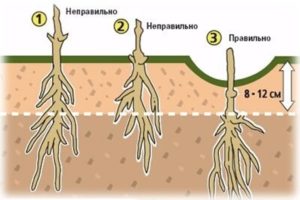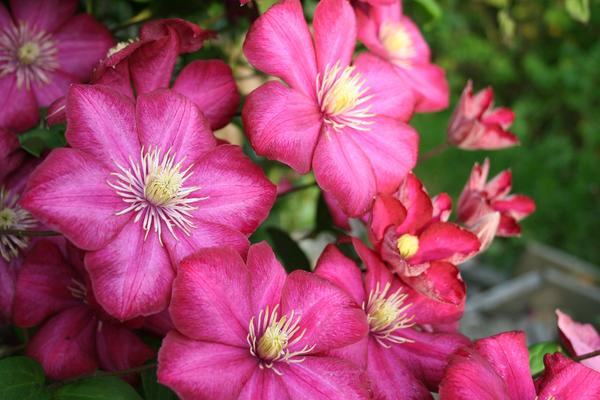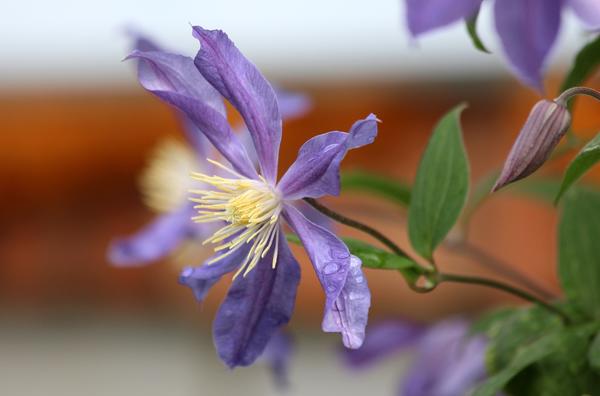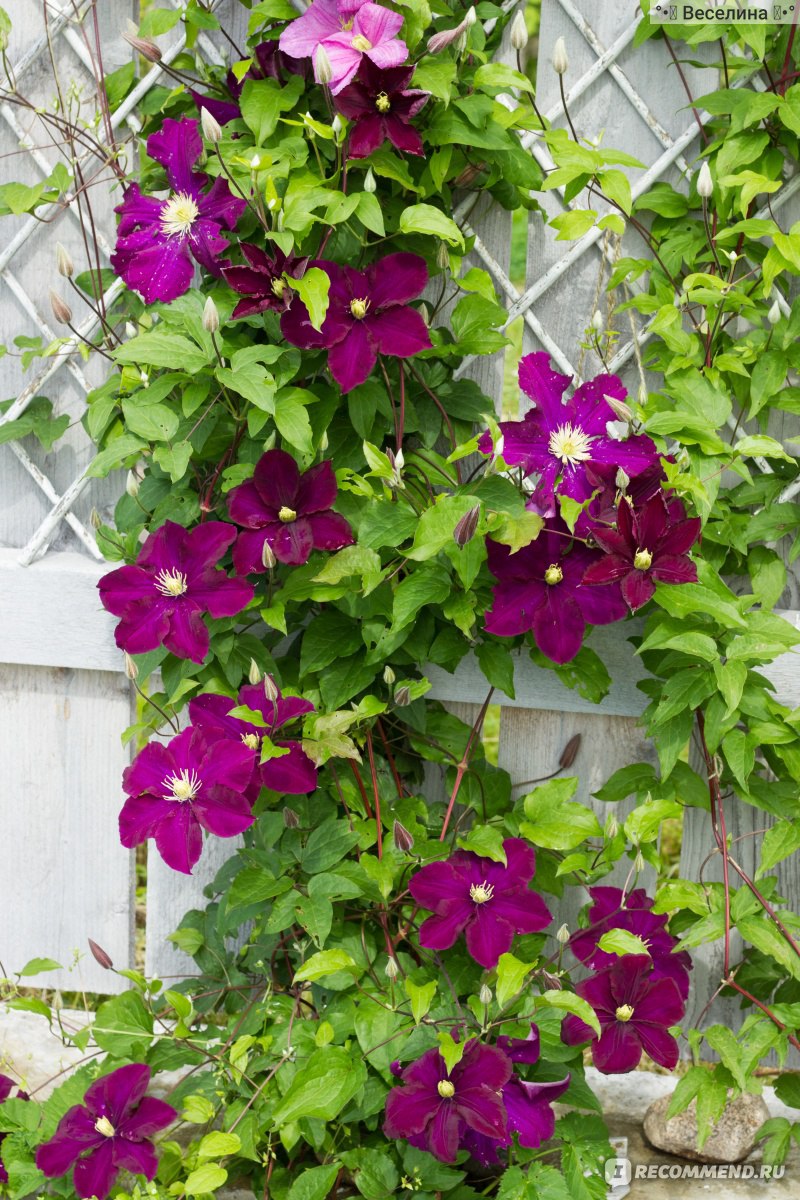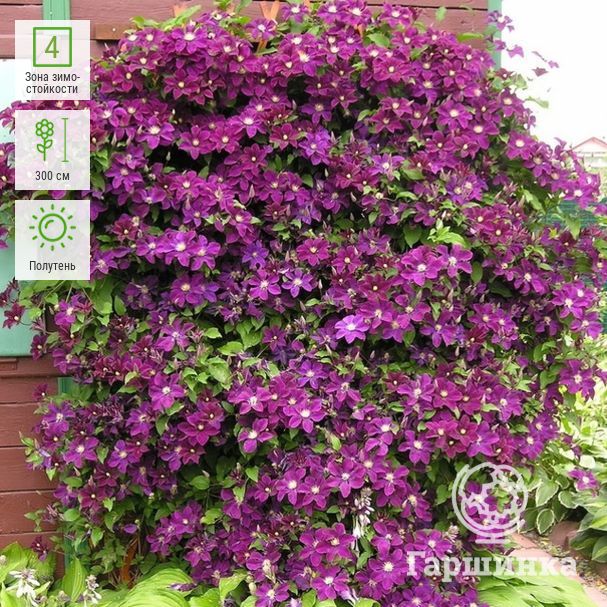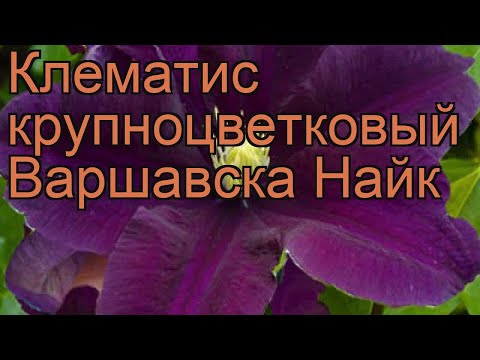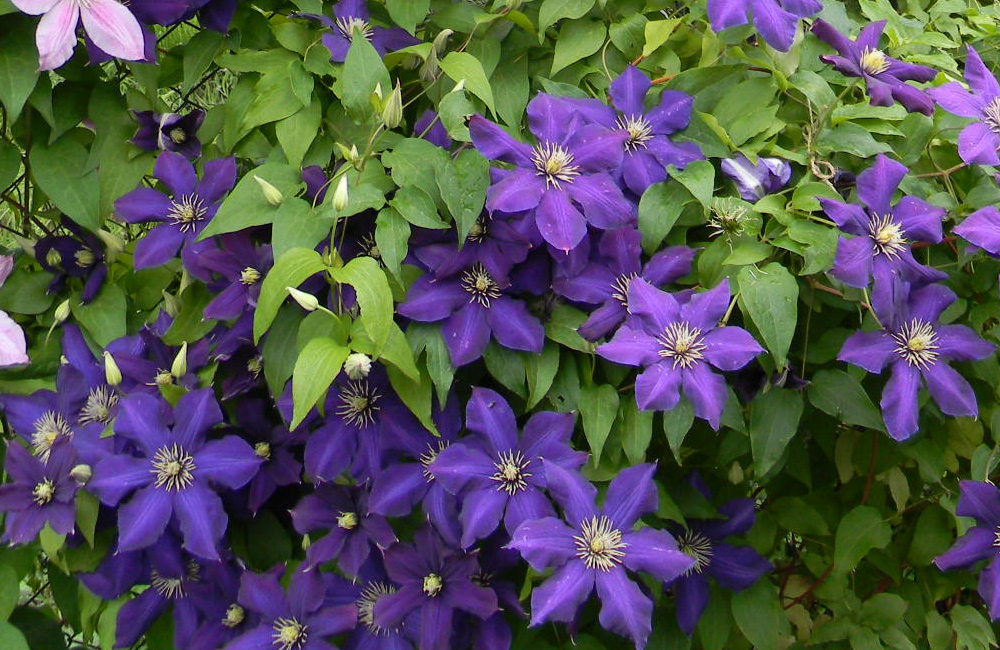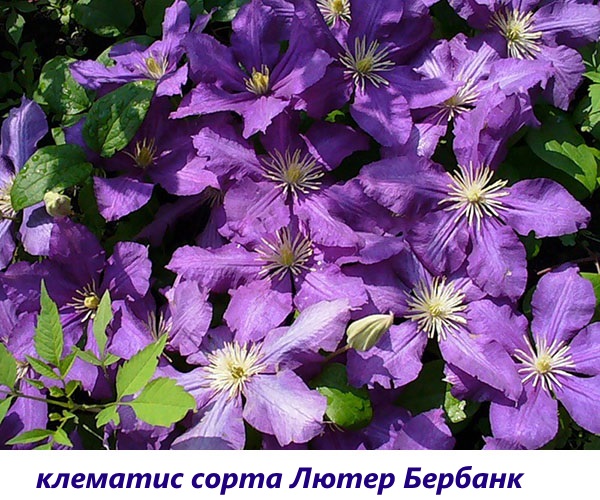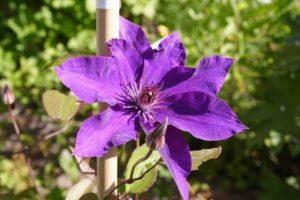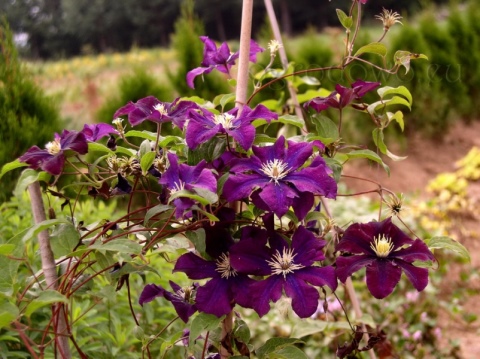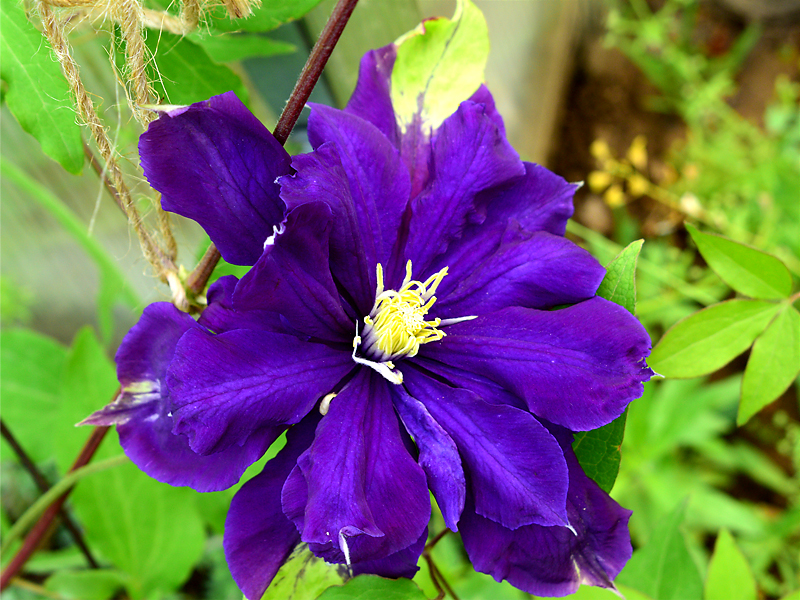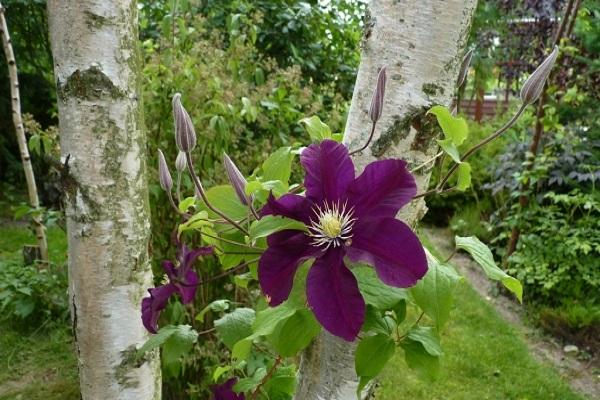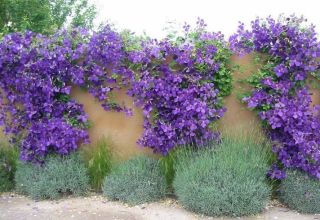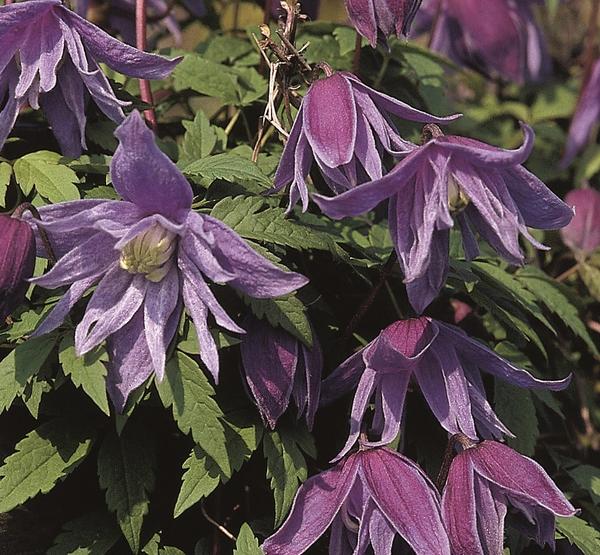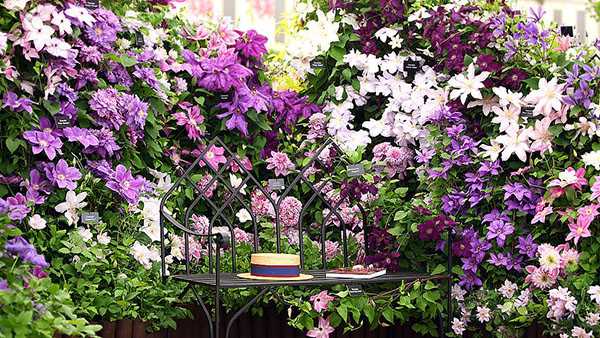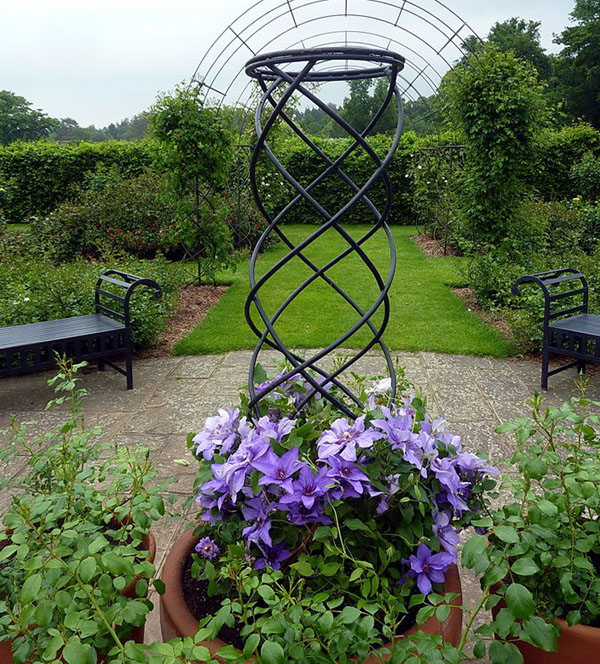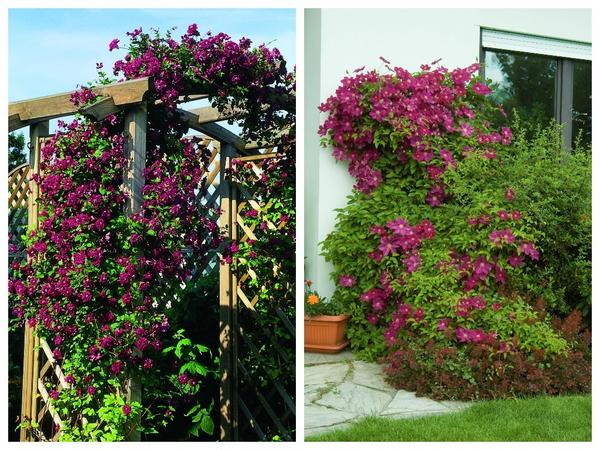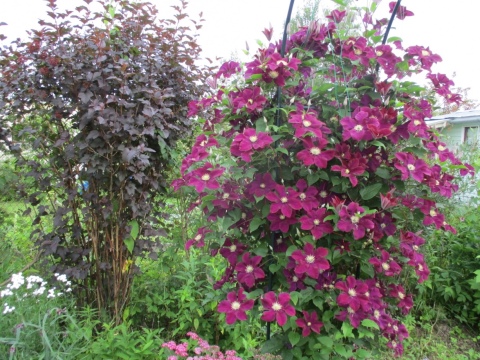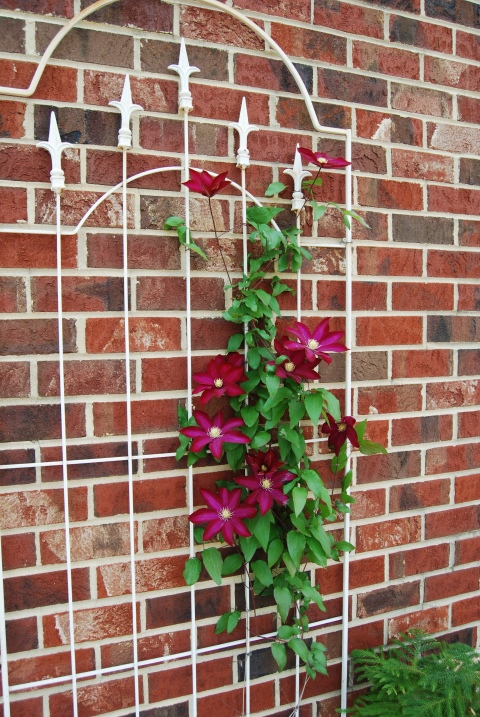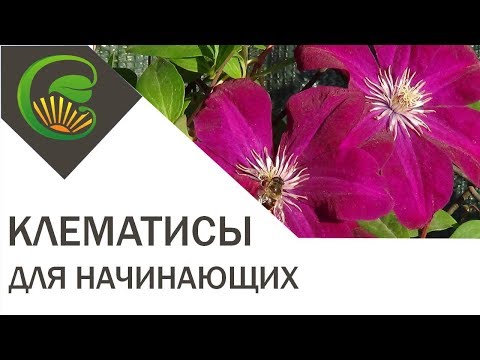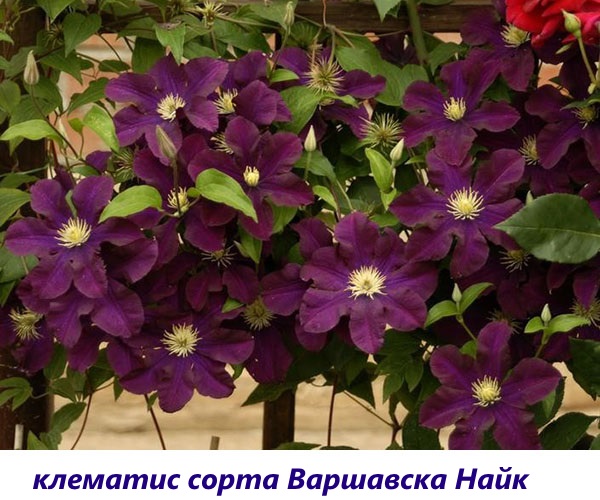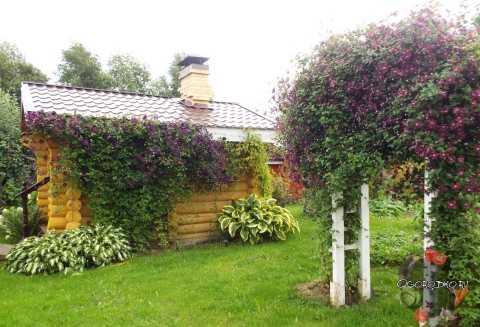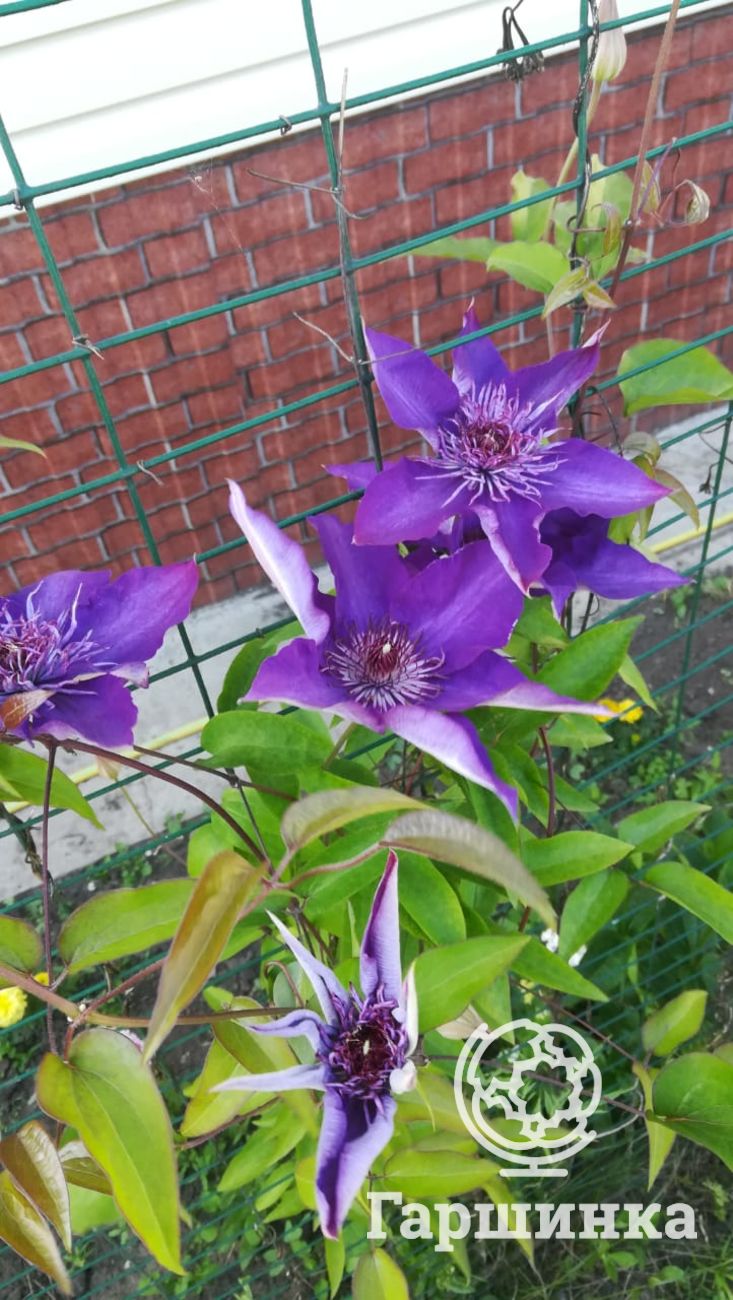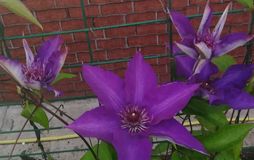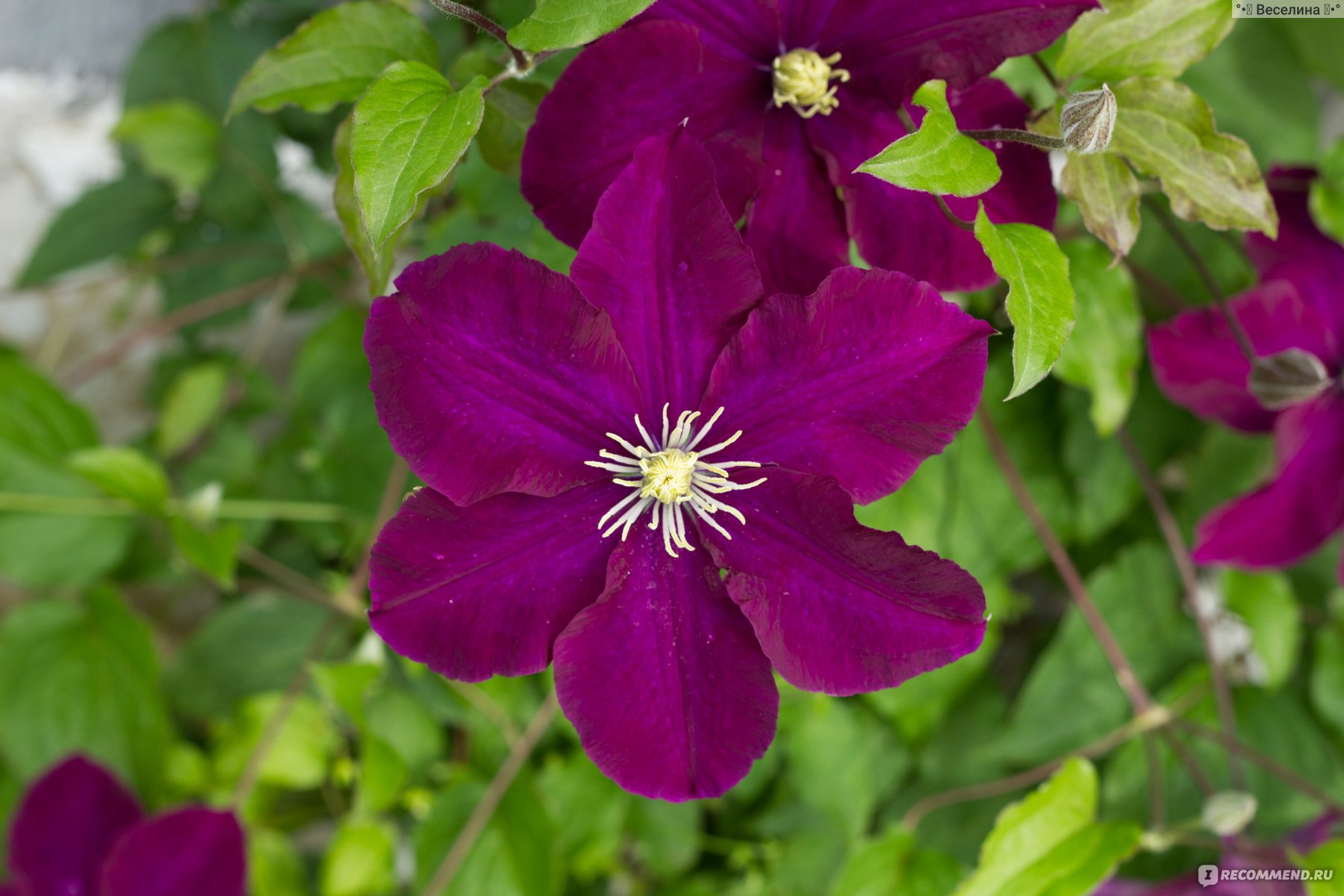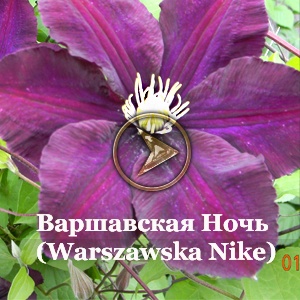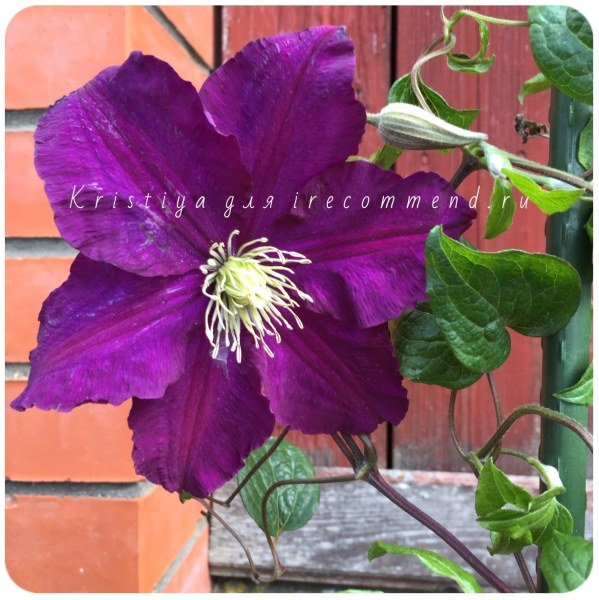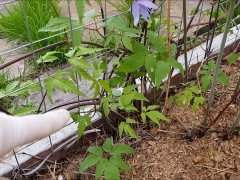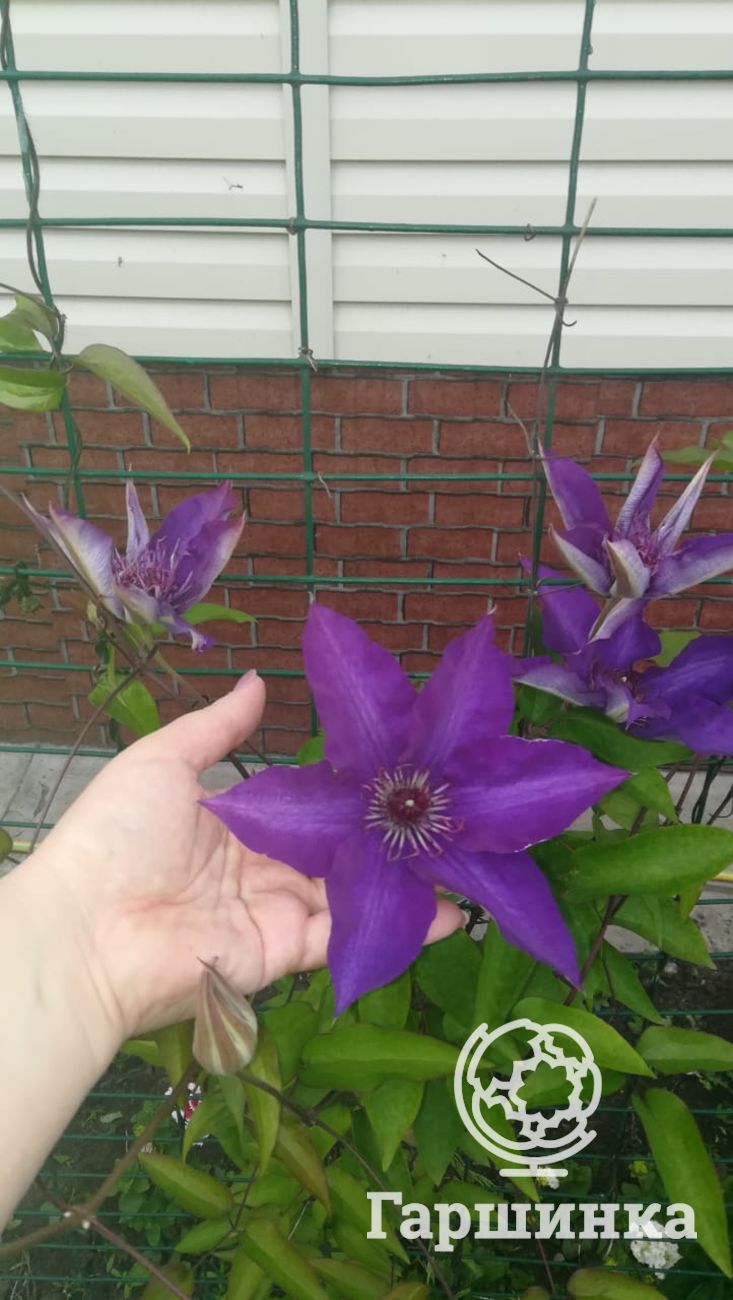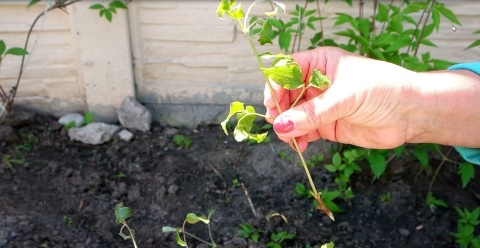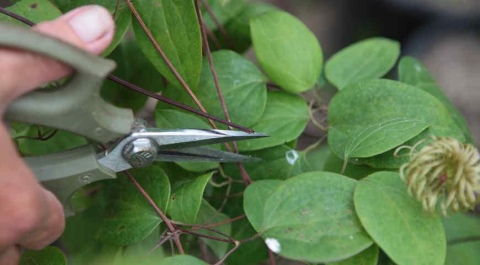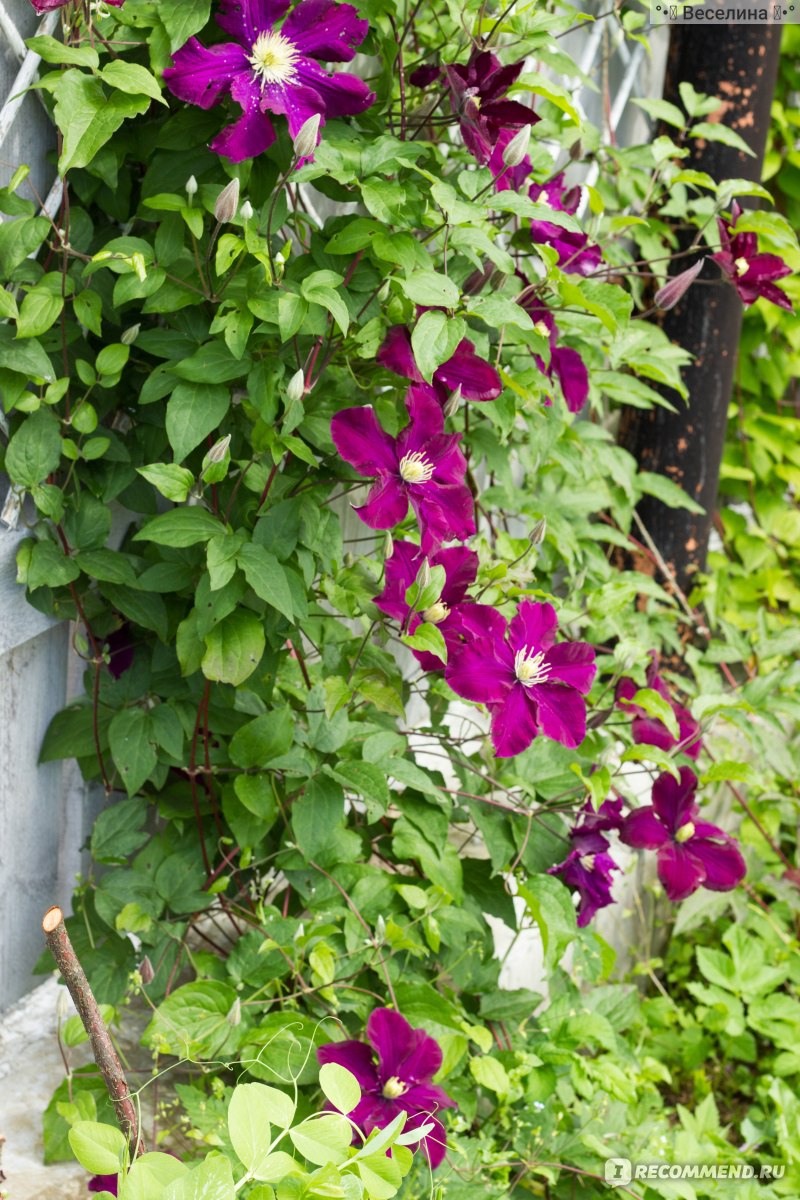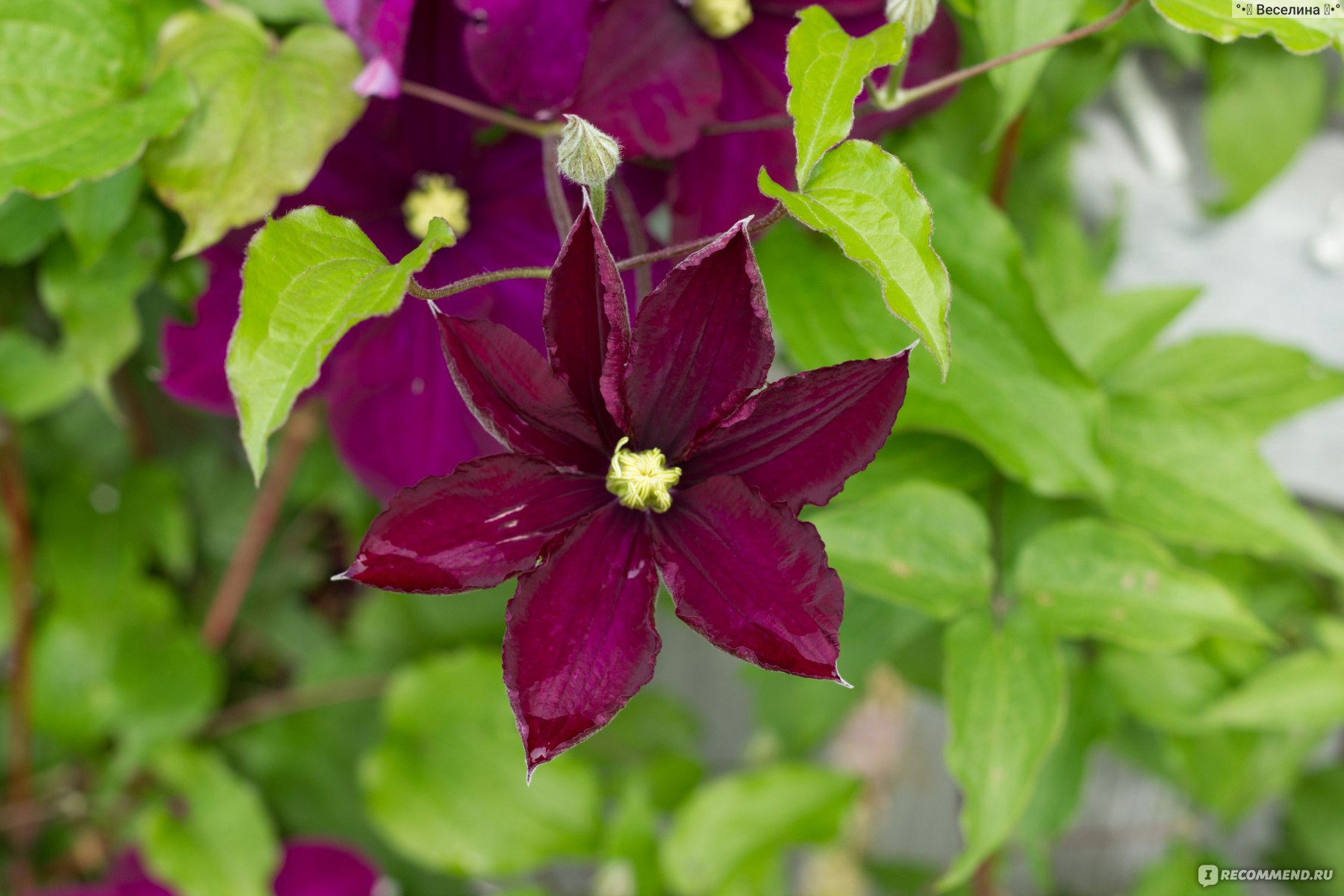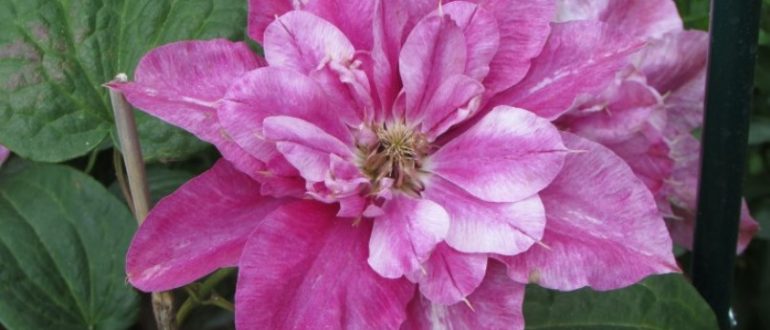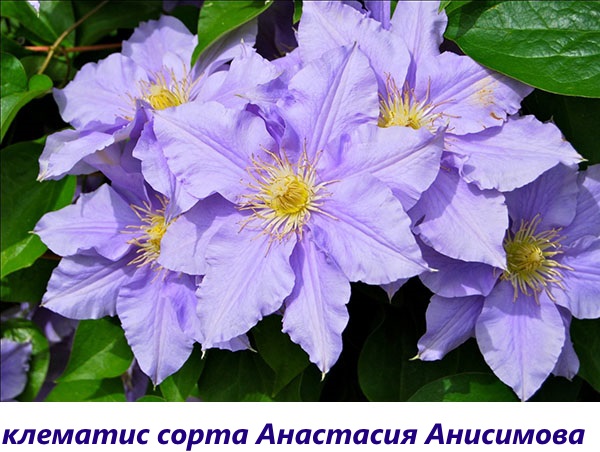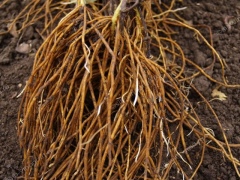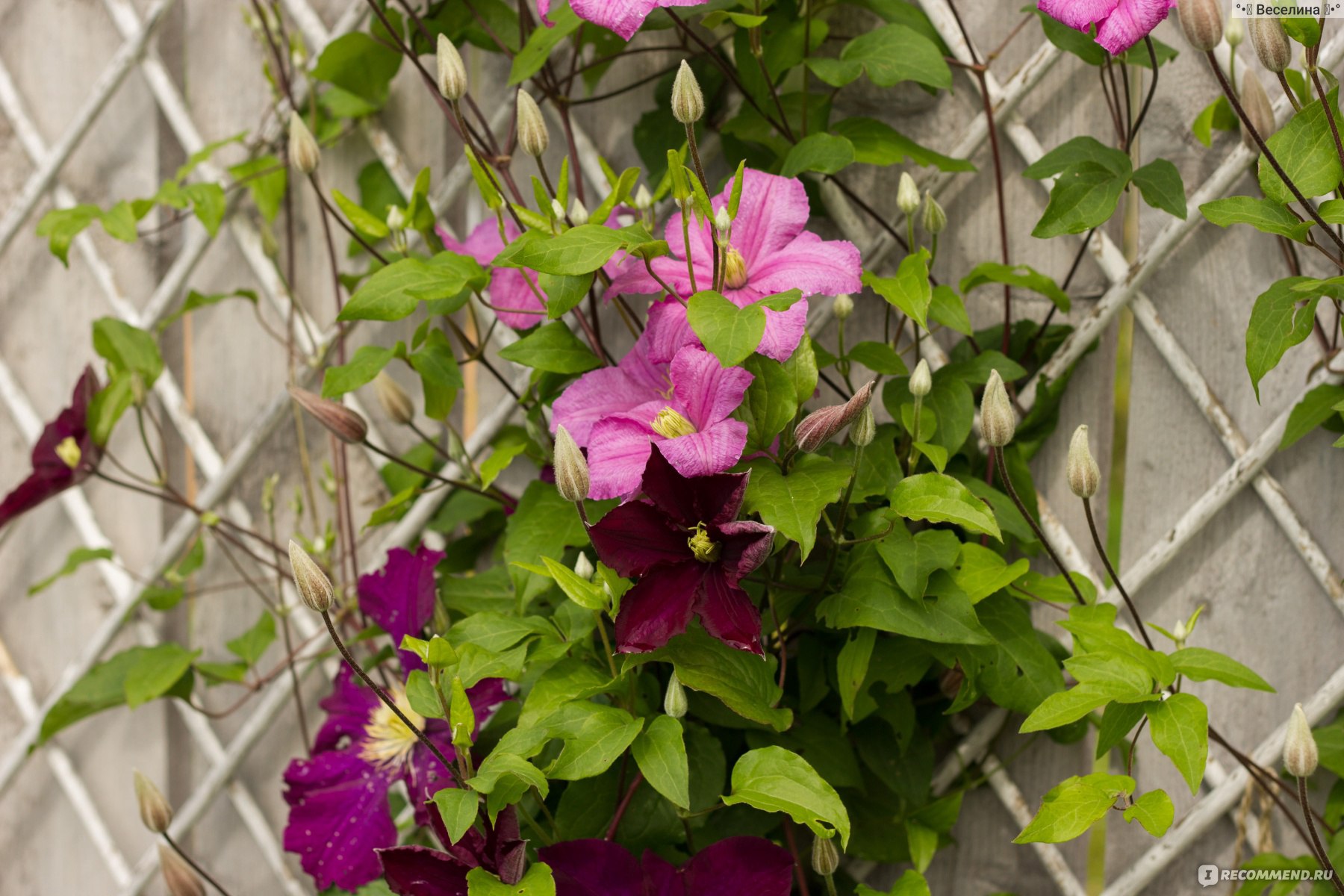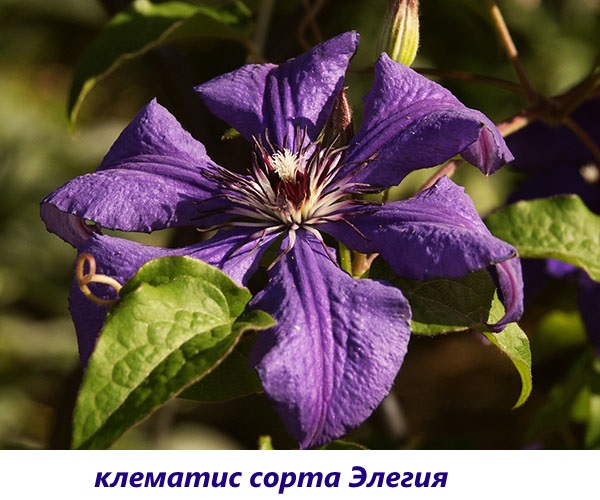The main characteristics of the variety
Consider the most important characteristics of this hybrid variety in the table:
| Parameter | Characteristic |
| Genus | Clematis or Clematis |
| Growth form | Shrub vine |
| Type of | Large-flowered |
| Group | Patens / Viticella / Jacquemana (according to various classifications) |
| general characteristics | Climbing, compact, unpretentious plant |
| Appointment | Vertical gardening in landscape design, container culture |
| Life cycle | Perennial |
| Reproduction methods | Mainly cuttings and layering |
| Shoot length | 2.5-3 m |
| Flowering type | On the shoots of the past and current years |
| Flowering period | In the southern regions, the first "wave" of flowering begins in May, the second - from July and lasts until cold weather |
| Flower sizes | 12-17 cm in diameter |
| Number of petals | 6-8 |
| Coloring flowers | At the base of the petals it is dark purple, closer to the middle and edges it is lighter with a lilac-purple tint; stamens are white; anthers - bright yellow |
| Trimming group | 2nd or 3rd (depending on the growing region) |
| Frost resistance | Average |
| Sustainability | Resistant to most common crop diseases, practically not damaged by pests |
| Registration in the State Register of the Russian Federation | Turned off |
Clematis was bred in 1986. The title includes the name of Nike, the Greek goddess of victory. The author dedicated a new variety to the memory of all Poles who died fighting for the freedom of their homeland during World War II. In 1992, the plant was awarded a silver medal at the Plantarium international exhibition, held annually in the Netherlands.
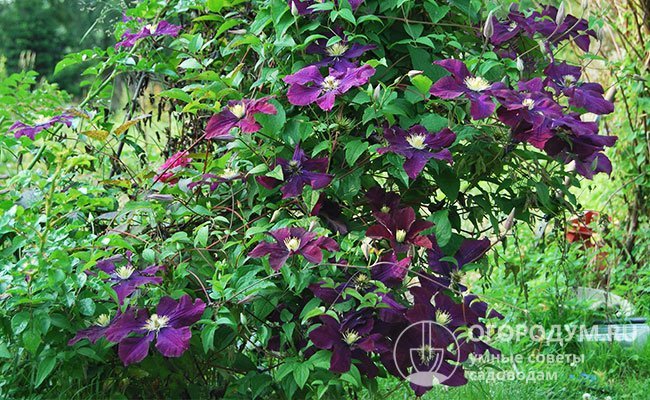 The plant is a shrub vine with woody stems up to 2.5-3 m long
The plant is a shrub vine with woody stems up to 2.5-3 m long
Clematis Warszawska Nike is a profusely flowering shrub vine with a stem length of 2.5-3 meters. Leaves are oval, dark green, smooth. The flowers are large (12-17 cm in diameter), consist of 6-8 petals, quite overlapping each other. The petals are broadly oval, with pointed tips and a velvety surface. The edges are sometimes wavy or slightly “curled” inward. The color at the base of the petals is dark purple. Closer to the middle and edges, it acquires a lighter, lilac-purple hue. The stamens are white, the anthers are bright yellow, almost golden. The flowers do not "fade" in the sun, but the intensity of their color may depend on factors such as the time of blooming of the buds, the location of the bush in the garden and even its age.
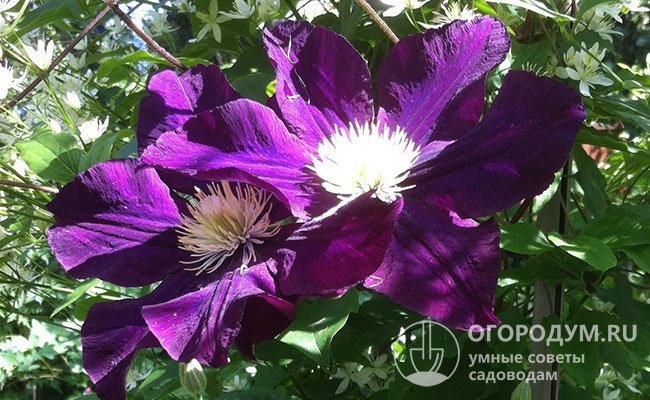 Large flowers consist of 6-8 petals, overlapping each other, with a velvety surface and a rich purple-violet color
Large flowers consist of 6-8 petals, overlapping each other, with a velvety surface and a rich purple-violet color
Despite the wide popularity of the plant, there is no exact data on its place in the classification. Some experts refer it to the Vititsella group, others to the Patens or Zhakmana groups.
Trimming group
There is also no clear idea of how to form the bushes of this variety in preparation for winter. Perhaps this is due to the fact that when grown in warm areas, the vine begins to bloom very early on overwintered shoots of the last year, then makes a short "break". The second "wave" of flowering begins in early to mid-July and can last until mid-late September. In regions with a more severe climate (including many countries of Western Europe), gardeners do not always manage to keep last year's whips until spring. Therefore, they prefer to radically shorten the entire growth in the fall and mulch the soil in order to avoid freezing of underground buds. In this version, the plants bloom exclusively on the shoots of the current year from July to the very frost.It turns out that those who consider the Varshavska Nike clematis trimming group to be the second, and those who attribute it to the third group, are also right.
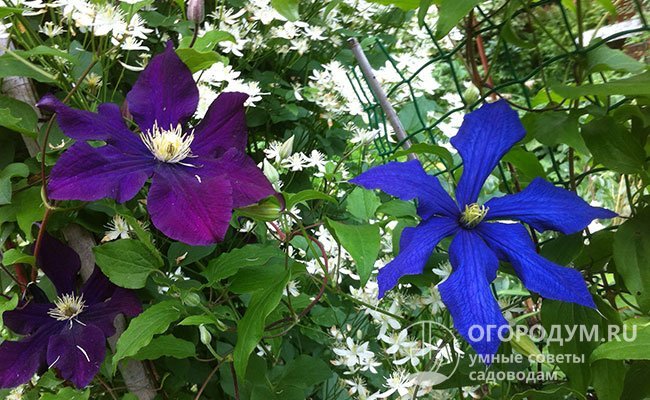 "Varshavska Nike" is perfectly combined with other varieties of clematis, suitable for growing in containers, therefore it is widely used in landscape design and in interiors
"Varshavska Nike" is perfectly combined with other varieties of clematis, suitable for growing in containers, therefore it is widely used in landscape design and in interiors
As for the reproduction of this variety, planting young plants and caring for the bushes, they practically do not differ from the agricultural technology of other large-flowered varieties of culture. According to gardeners, Clematis "Varshavska Nike" is quite unpretentious and its cultivation, as a rule, is not particularly difficult. Liana is perfect for decorating garden objects and for growing in containers to decorate balconies, loggias and patios. With a competent approach to the formation of bushes, the variety can be used in the design of the interiors of halls and office premises.
Video
For those who are interested in the variety, we suggest watching videos on the topic of the article:
Graduated from MGRI them. Ordzhonikidze. His main specialty is a mining engineer-geophysicist, which means a person with an analytical mindset and various interests. I have my own house in the village (respectively, experience in truck farming, gardening, mushroom growing, as well as fiddling with pets and poultry). Freelancer, perfectionist and "bore" in relation to his duties. Hand-made lover, creator of exclusive jewelry made of stones and beads. A passionate admirer of the printed word and an anxious observer of everything that lives and breathes.
Found a bug? Select the text with the mouse and click:
One of the most convenient methods to prepare a grown crop of vegetables, fruits and berries is freezing. Some people believe that freezing leads to a loss of the nutritional and beneficial properties of plant foods. As a result of the research, scientists have found that there is practically no decrease in nutritional value when frozen.
It is necessary to collect medicinal flowers and inflorescences at the very beginning of the flowering period, when the content of nutrients in them is as high as possible. Flowers are supposed to be picked with hands, breaking off rough pedicels. The collected flowers and herbs are dried, scattered in a thin layer, in a cool room at a natural temperature without access to direct sunlight.
Both humus and compost are rightfully the basis of organic farming. Their presence in the soil significantly increases the yield and improves the taste of vegetables and fruits. They are very similar in properties and appearance, but they should not be confused. Humus - rotted manure or bird droppings. Compost - rotted organic residues of various origins (spoiled food from the kitchen, tops, weeds, thin twigs). Humus is considered a better fertilizer, compost is more readily available.
Oklahoma farmer Carl Burns has developed an unusual variety of colorful corn called Rainbow Corn. The grains on each ear are of different colors and shades: brown, pink, purple, blue, green, etc. This result was achieved through many years of selection of the most colored common varieties and their crossing.
It is believed that some vegetables and fruits (cucumbers, stalk celery, all varieties of cabbage, peppers, apples) have a "negative calorie content", that is, digesting more calories than they contain. In fact, the digestive process uses only 10-20% of the calories from food.
A novelty of American developers is the Tertill robot, which weeds in the garden. The device was invented under the guidance of John Downes (the creator of the robot vacuum cleaner) and works autonomously in all weather conditions, moving on uneven surfaces on wheels. In doing so, he cuts all plants below 3 cm with the built-in trimmer.
Natural toxins are found in many plants; those that are grown in gardens and orchards are no exception.So, in the seeds of apples, apricots, peaches there is hydrocyanic (hydrocyanic) acid, and in the tops and peel of unripe nightshades (potatoes, eggplants, tomatoes) - solanine. But do not be afraid: their number is too small.
In Australia, scientists have begun experiments to clone several grape varieties from colder regions. Climate warming, which is predicted for the next 50 years, will lead to their disappearance. Australian varieties have excellent characteristics for winemaking and are not susceptible to diseases common in Europe and America.
The homeland of pepper is America, but the main breeding work on the breeding of sweet varieties was carried out, in particular, by Ferenc Horvat (Hungary) in the 1920s. XX century in Europe, mainly in the Balkans. Pepper came to Russia from Bulgaria, therefore it got its usual name - "Bulgarian".
{SOURCE}
Diseases and pests
Like any other plant, "Warsaw Night" can get sick or become the target of insect pests. Consider the most common troubles that the owner of clematis may face.
Rust. The spots on the shoots and leaves will tell about its appearance. Their color is bright orange, like an orange peel. The problem cannot be ignored, since over time, the shoots will begin to deform, and the leaves will dry out. Such preparations as "Hom", "Topaz", Bordeaux liquid (1% solution) will get rid of rust. They need to process the plant. Preventive measures include removing weeds and affected branches.

Gray rot. Favorable conditions for its appearance are very high humidity. Signs - brownish-grayish round spots with a silvery bloom. You need to start the fight immediately, since rot spores are easily carried by the wind, and they are able to infect nearby plants. Means of struggle are "Azatsen" (2% solution), "Fundazol"
Everyone can prevent the problem: it is important to avoid excessive watering and stagnation of water in the hole
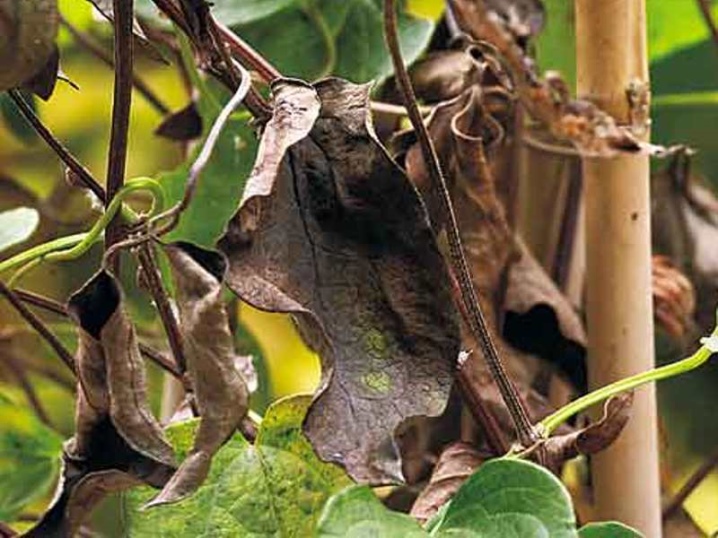
Powdery mildew. The disease affects absolutely all terrestrial parts of the plant. Untimely treatment will lead to the death of the plant: the shoots will fall off. Spraying with soda or "Topaz" will help get rid of powdery mildew.
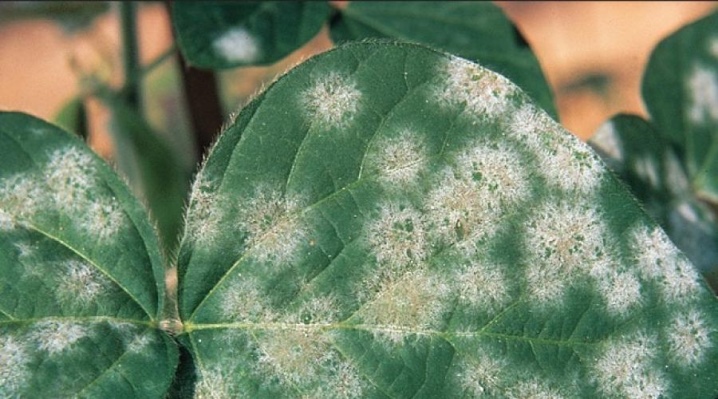
Wilt. The disease is caused by a microscopic fungus that lives in the soil. Its action is aimed at clogging the pores of the plant. Clematis cannot breathe, sheds leaves. Signs of the disease - the appearance of brownish-brown spots on the leaves. You can get rid of wilt with the help of fungicides with a wide spectrum of action. Treatment will only help if the disease is at an early stage of development.
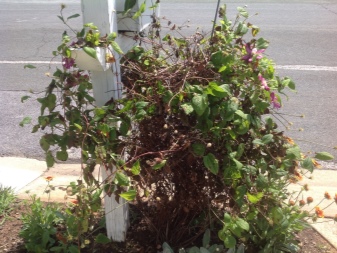
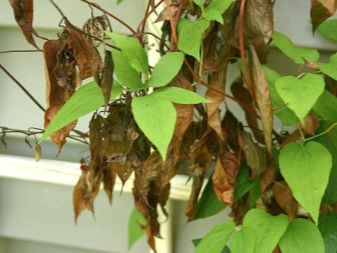
Nematodes. They are small worms that grow in the roots of a perennial. You can even purchase an already infected plant. A sign of damage is the appearance of thickenings and growths on the roots. Exposure to pests causes the growth of clematis to stop. In this case, the leaves become small, flowers may not form, existing buds fall off. If the problem is running, then the plant cannot be helped. It must be removed from the ground and burned. Further, the soil is treated with special chemicals at the site of the seedling.

Soil and landing site
Plots like light, with good access to the sun, but protected from drafts and wind. But at the same time it cannot stand overheating of the soil. Therefore, it is better to shade the base of the bush with low green annuals.
The soil needs moisture permeable, loamy, calcareous or neutral, fertile, well fertilized and loose, also with good drainage, since the plant does not like stagnant water.
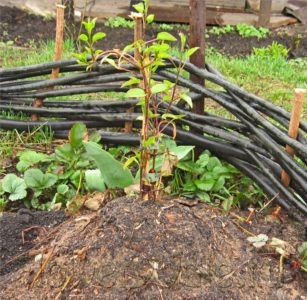
Liana is quite frost-resistant, so it can be planted in many regions from south to north.
Before planting, you need to prepare the site. This is best done a month before disembarkation. During this time, the earth will sag slightly, ideal conditions are formed for strong rooting of the vine.To do this, dig holes measuring 60x60x60 cm (depth / width / height), a little more is permissible. The bottom of the hole is certainly covered with drainage from crushed bricks, stones, perlite. The thickness of the drainage should not be less than 10 cm. It is recommended to lay rotted manure or decayed foliage on top of it. Then the depression is filled with ash, enriched earth.
Clematis will not grow in acidic, salty, damp, heavy soil. Ground waters are dangerous for him. It is worth choosing places on the hills or manually making elevations using the filled earth. When the soil is made of clay at the landing site, it is necessary to dig a channel for the excess liquid to escape, fill it with sand.
After preparing the site, before planting itself, you need to fix the support. You do not need to plant clematis too close to the wall or fence, because the soil directly under the buildings is dry and infertile, where the vine will grow and develop poorly. The distance should be at least 20 cm. At a distance of 30 cm from the wall, fasteners must be installed, this will protect the vine from water that will drain from the roof of the building.
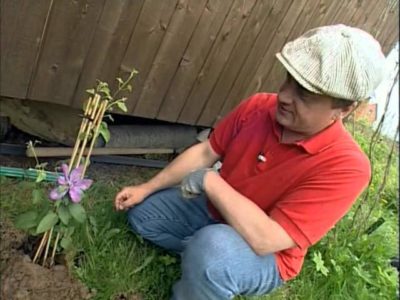
Diseases and pests
All existing plant diseases are divided into 2 groups: infectious and non-infectious. Infectious diseases are caused by fungi, bacteria and viruses. Non-communicable diseases are caused by unfavorable growing conditions.
All measures aimed at plant health are divided into preventive and therapeutic ones. Preventive measures are carried out annually, all healthy plants are processed. Therapeutic measures are carried out when signs of diseases or pests appear.
The main enemies of clematis are fungal diseases. The most dangerous of these are fusarium and wilt (wilting). These diseases are promoted by high air humidity and waterlogging of the soil. The best control and prevention measures are compliance with agrotechnical measures, a good place for clematis planting. If any fungal disease manifests itself, it is necessary to carry out a sanitary pruning of the damaged parts of the plant, all cut-out remains must be burned.
Good results for the prevention of diseases and pests are obtained by planting next to clematis of calendula or marigolds. These annuals shade the base of clematis shoots, scare away pests with their specific smell, do not complicate weeding, as they are removed in autumn. In addition, most clematis look very beautiful against the background of these yellow-orange plants.
Landing
"Warsaw Night" needs a bright place where there will be plenty of sun. However, excessive overheating negatively affects the condition of the plant, therefore, if there is an excess of sunlight on the site, then shading will be required. For this purpose, you can use stunted annuals. Clematis does not like draft and wind.
If the region has a cold climate, then the hybrid is planted in late April or early May. In the southern regions, this can be done even in September.
It is important that the seedling has more than one shoot
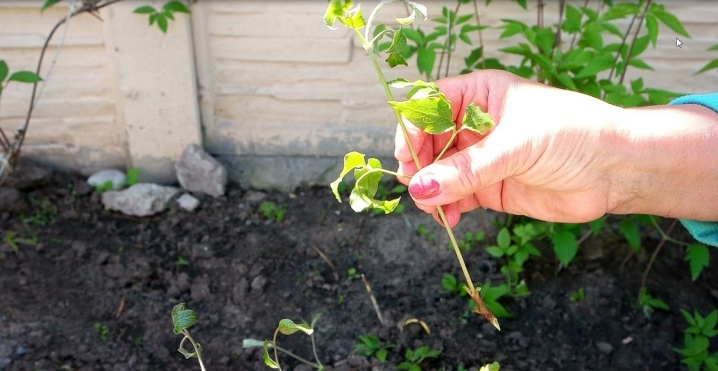
The perennial is planted in fertile soil, light and slightly alkaline. If the soil does not meet these requirements, then add peat or sand (1 bucket), compost (2-3 buckets), superphosphate (150 g), dolomite flour (400 g) to it. All components must be thoroughly mixed and added to the soil. This procedure is carried out 1.5-2 months before the expected disembarkation of clematis.
To plant a plant, prepare a hole with a diameter of 60 cm. A drainage layer must be poured onto the bottom, for example, small fragments of brick. This is necessary to prevent stagnation of water, which is contraindicated in clematis. This is followed by a layer of nutritious soil, the perennial is placed on top, the roots are carefully straightened. The last stage is dusting with another soil layer.
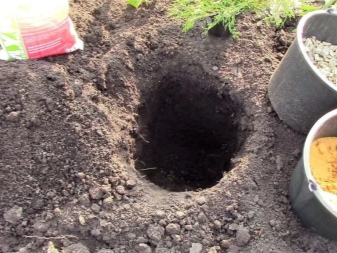
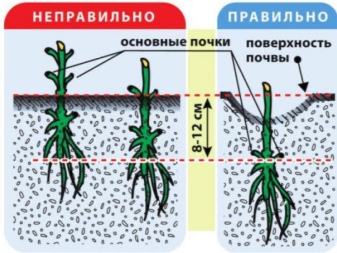
Clematis should be watered abundantly once a week. If the weather is very hot, which is typical for the southern regions, then watering is carried out twice a week.The volume of water is directly proportional to the age of the plant, but in any case, at least 10 liters at a time will be required. The plant will indicate the lack of moisture by itself: its flowers will become smaller in size and lose their bright color, the branches will grow more slowly or their growth will stop altogether.
To prevent the roots of the perennial from rotting, watering is done around the perimeter. The foliage is not affected. To do this, you need to retreat from the central part of the plant by 30 cm.
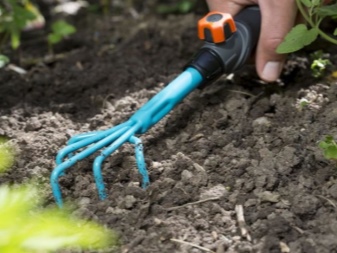
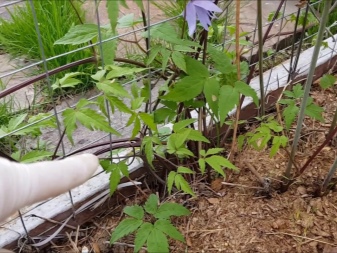
Fertilizers can be applied twice a month. Before starting the process, carefully read the instructions attached to the substances. Each stage of the development of "Warsaw Night" needs its own feeding:
- buds swell - nitrogen-containing fertilizers;
- bud formation - potassium and phosphorus;
- autumn flowering - fertilizers containing a complex of minerals;
- autumn pruning - wood ash.
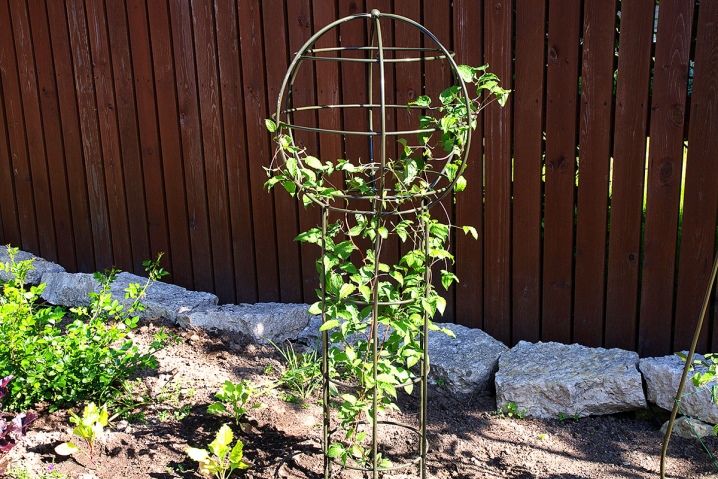
Loosening and mulching

After each watering, it is necessary to loosen the soil around the plants. So that oxygen better penetrates the roots for the successful development and growth of the green mass. Loosening is mandatory after the snow melts. When the ground is dry enough.
At the same time, weeds are removed. It is best to lay out a good layer of mulch. The procedure will save you from the need for frequent watering and weeding in the future. And also a layer of mulch allows you to retain moisture in the soil. And closes the root system from direct sunlight.
Rotted manure, dried leaves are perfect as mulch. And also compost or humus. When mulching with plant residues, it is also necessary to apply fertilizers. They must contain nitrogen. The bacteria that will digest these plant debris need nitrogen. They will take it from the soil. As a result, the plant itself will be deprived of the required concentration of the substance.
Planting and leaving
Clematis can be planted from spring to fall. But the best time will be 1 half of autumn. After the place is completely ready, you can land the Warsaw Night. If the roots are dry, then before planting you need to soak them in cold water for a few hours. Pour a small hill from the ground into the base of the hole, place the seedling on it so that the roots spread evenly along the embankment of the earth. Rhizome, root collar and part of the trunk (if any) 5-10 cm high must be covered with soil. In addition, you need to make a small depression so that when watering, the water does not spread past the hole.
If planting in spring, then you need to cover it with earth up to the first internode. Pour with a bucket of water. During the summer until autumn, pour a little earth into the hole so that it is completely filled.
If planting in the fall, then in the spring you can also take away part of the soil, and pour it back over the summer. This is done to facilitate the emergence of young shoots in a weakened plant after transplanting.
When more than 1 individual are planted, then the distance between them should not be less than 1.5 m.
With correct planting and high-quality maintenance, clematis can exist on 1 site for 30 years or more.
It is recommended to purchase seedlings in a plastic container with fertilizers. This preserves the root system, which may be damaged during planting. The plant will surely take root quickly enough. In early spring or late autumn, you can purchase a liana with a bare root. She, too, will take root very well.
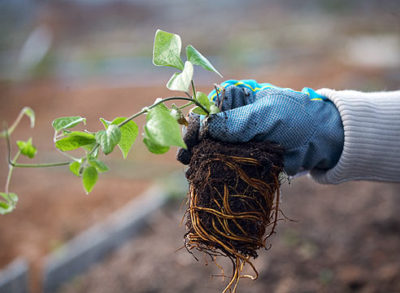
When the vine has taken root, then watering is carried out once a week. If the summer is dry and sultry, then it is recommended to slightly increase the number of waterings. One-year-old needs 10-20 liters of water for 1 watering. Subsequently, the volume of water is increased to 20-40 liters at a time. After moistening, it is recommended to fluff the soil, remove weeds.
Organic and mineral fertilizers will not be superfluous. During the growing season, you can make 3-5 dressings. If clematis grows in poor sandy soil, then it is advised to add compost obtained from waste from a house, garden, vegetable garden, or old humus.Organic fertilizers increase the number of soil bacteria, lighten the soil, saturate it with oxygen.
Important: clematis does not tolerate fresh manure and sour peat
Preparing for winter
Despite its excellent frost resistance, "Warsaw Night" requires a number of activities that will help it survive the winter calmly. This should be thought about even at the landing stage. It is necessary to deepen the root system well so that it does not freeze out.
In late autumn, when the flowering process is completed, they begin winter preparation. For this, all foliage is removed from the shoots, since it is a hotbed for the development of fungal spores. Old mulch and other plants under the bush are also removed.
The root collar and branches are treated with Bordeaux liquid (1% solution). This stage must be carried out until the soil is frozen. A mixture of sand and ash is poured onto the root collar. You will also need rotted manure or peat.
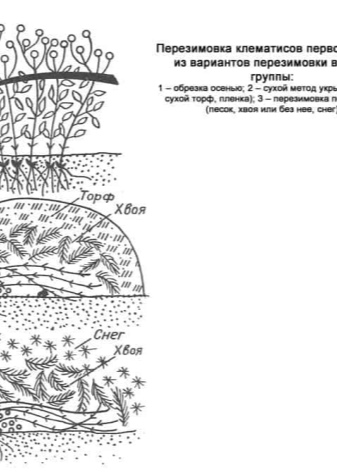
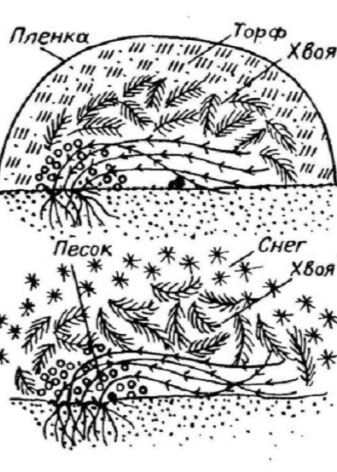
The shoots remaining on the bush after pruning are carefully twisted and laid on the ground. A layer of spruce branches is laid on top, and then a special covering material. In the lower part of it, you need to leave a place so that air can freely flow to the plant.
In the spring, with the onset of the thaw, the winter protective layer is removed. It is advisable to do this in cloudy weather. Further, clematis will need top dressing. To do this, dilute urea in warm water - 10 g per bucket of water.
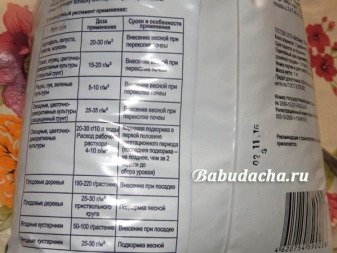
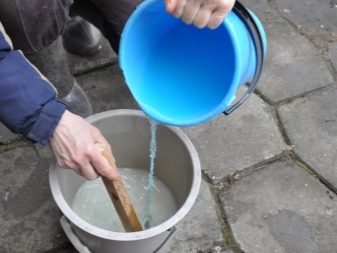
Reproduction
Seeds
It is impossible to propagate hybrid large-flowered clematis by seeds, because the grown seedlings do not repeat the properties and varietal characteristics of the parent plant, the method is suitable only for the reproduction of species small-flowered clematis.
Division of the bush.
This is the easiest way of breeding clematis available to every flower lover. You can divide the bushes 5-6 years after planting, in autumn or spring. Dig up the bush, divide it into several parts, plant each part according to the rules set out in the landing section.
If the bush is very large and it is not possible to dig it up, then you need to dig it up on one side and separate part of the plant with a shovel.
- Advantages of the method: the resulting plants bloom quickly.
- Disadvantages: all diseases of the mother bush are transmitted, in some cases the plants do not take root well due to a violation of the balance of roots and shoots.
In spring or autumn, grooves are radially dug from the bush, 5-10 cm deep. Lateral shoots are laid in these grooves, pressed with wire brackets, covered with earth or peat. After a year, the rooted shoots can be separated from the plant and planted independently.
- Advantages of the method: easy to use, does not reduce the decorative effect of the mother bushes.
- Disadvantages: diseases of mother plants can be transmitted, not suitable for industrial use.
Description and features
Clematis warszawska nike was bred by a Catholic monk from Poland S. Franczak. For 1 warm night, the length of the vine grows by 10 cm. For 1 season, the flower forms 1-5 shoots. Inflorescences are velvety, large in size, solid color of ripe cherries 17 cm in diameter.
The flowers look charming due to the large stamens in a contrasting light tone. The buds do not fade in the sun for a long time. The leaves are wrinkled, green, ovoid. Over the summer, clematis blooms 2 times. The process begins in June and lasts until late autumn. The plant can withstand frosts down to -35.
Planting and leaving
Warszawska Nika is a winter-hardy, unpretentious variety. Any areas with loose, more or less fertile soil are suitable for planting it. Even planting at the northern wall is allowed, although, of course, in such conditions, clematis blooms worse.
It is necessary to plant in early spring or autumn. Before planting, it is better to rinse the roots to cut off all rotten and damaged ones and sprinkle the cuts with a mixture of ash and sand. If you have to plant in the summer, you do not need to rinse the roots, you need a transshipment.
The third trimming group.In autumn, clematis is pruned at about 30 cm above a pair of strong buds and the remnants are covered, it hibernates almost always well.
In spring, clematis is spilled with milk of lime (200 g of lime per 10 liters of water per square meter). In dry weather, clematis are watered not often, but abundantly, making sure that the stream of water does not fall into the center of the bush. Clematis are fed at least four times per season after irrigation with full mineral fertilizer with microelements at the rate of 20-40 g per 10 liters of water or a diluted fermented mullein (1:10).
To protect the soil from overheating and to close the lower part of the shoots, clematis are “knocked out” by the lettucers. In the spring, only for the first time, the vines are directed along the support in the right direction and tied up. Otherwise, the growing shoots will intertwine so strongly that no forces will be able to untangle them. Only in the varieties of the Integrifolia group, shoots and leaves are deprived of the ability to wrap around supports, therefore they are tied up as they grow all summer.
In the fall, before sheltering for the winter, clematis bushes are cut and carefully cleaned of old leaves. The first two to three years, young specimens require particularly careful care: in the fall or early spring, well-rotted manure mixed with any potash and phosphorus fertilizer, as well as wood ash (a handful of each per bucket of humus) is poured onto the bushes, liquid top dressing is done every 10 15 days in small doses.
Reproduction
Clematis are preferably propagated vegetatively using different parts of them. There are also several breeding methods.
- Green cuttings. Shoots are cut from an adult clematis in the bud formation stage. Take material from the middle of the plant, with 1 knot. You can cut off no more than 1/3 of the part. Petioles are treated in growth-stimulating solutions, germinated in containers with peat or sand.
- Layers. In the fall, one of the shoots is pressed to the ground, sprinkled with it. When individual branches sprout, they are separated, grown.
- Division of the bush. Take clematis 5-6 years old. They should be completely dug out, the rhizome should be divided. This breeding method is the most favorable.
Clematis seeds are almost never propagated, there is a high risk of getting a dissimilar plant.
Cooking Clematis Varshavska Nike for winter

This variety of clematis belongs to frost-resistant plants. And even withstands harsh winters. But for this to happen, the rules for preparing the plant for winter should be followed. And also the rest of the rules of care.
You have to wait for the culture to finish blooming. If the cold has already come, and the flowers are still there, then they should be removed on their own. And pinch the shoots. You also need to cut off the remaining leaves. And remove the old layer of mulch.
The remaining shoots should be treated with a Bordeaux liquid solution. The root collar is covered with sand mixed with ash. Also, the shoots that remain after pruning must be insulated with rotted manure.
If you are pruning according to the rules of the second group, then the remaining shoots must be collected in a bunch. And also press it to the ground, covering it with spruce branches on top. You can also add a layer of non-woven material. But it should be done so that air passes freely below. Gradually, with the onset of spring and an increase in the daytime air temperature, the shelter is removed. And spread the stems of the plant.
Care
Clematis should be watered abundantly once a week. If the weather is very hot, which is typical for the southern regions, then watering is carried out twice a week. The volume of water is directly proportional to the age of the plant, but in any case, at least 10 liters at a time will be required. The plant will indicate the lack of moisture by itself: its flowers will become smaller in size and lose their bright color, the branches will grow more slowly or their growth will stop altogether.
To prevent the roots of the perennial from rotting, watering is done around the perimeter. The foliage is not affected. To do this, you need to retreat from the central part of the plant by 30 cm.


Fertilizers can be applied twice a month.Before starting the process, carefully read the instructions attached to the substances. Each stage of the development of "Warsaw Night" needs its own feeding:
- buds swell - nitrogen-containing fertilizers;
- bud formation - potassium and phosphorus;
- autumn flowering - fertilizers containing a complex of minerals;
- autumn pruning - wood ash.

Planting clematis Varshavska Nike
Before buying a young clematis seedling Warsaw Night, you need to study the description of the variety, view the photo and prepare the planting site in a timely manner. The duration of flowering and the size of the inflorescences depend on the correctly carried out planting.
Landing dates
Since the Varshavska Nike variety wakes up in early spring, an autumn planting of a seedling is carried out a month before the onset of cold weather. If the planting material was purchased in late autumn and in a warm room it came out of hibernation, then it is necessary to create favorable conditions for it before disembarking to a permanent place:
- the seedling is placed in a moderately warm place, away from heating appliances;
- since there is little light in the autumn-winter period, additional lighting is installed;
- as the soil dries out, abundant watering is carried out with water at room temperature;
- to increase the humidity of the air, a humidifier or a bowl of water is installed next to the clematis.
With proper care, clematis can release new shoots during the winter, which are shortened during spring planting. Such seedlings will not differ from overwintered specimens and will show their flowering in early summer and autumn.
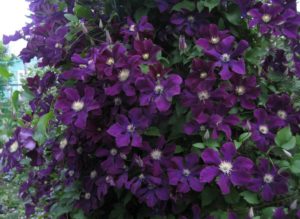
Planting site and soil preparation
To see abundant and long-lasting flowering, the planting site should be located in a sunny place, protected from wind and drafts. Clematis prefers a nutritious, light, well-drained soil with neutral acidity. Clematis will not grow on acidic, heavy soil with stagnant water, since an excess of liquid leads to decay of the roots and death of the vine.
Important! If Varshavska Nike grows near the fence, then the distance from the building to the landing hole should be at least 30 cm.
30 days before planting, they dig a hole 60x60x60 cm.The bottom is closed with drainage, rotted manure or compost is added and covered with nutritious soil.
Preparation of planting material
It is better to purchase a clematis sapling of the Varshavska Nike variety from responsible suppliers, in a nursery or a greenhouse. To get 100% rooting, clematis is bought at 2-3 years of age.
If the seedling is purchased with a closed root system, it is carefully removed from the container and placed in the hole with a lump of earth. If a young clematis has open roots, the seedling is kept for 20-30 minutes in a root formation stimulator.
Important! During transplantation, the vine gets stressed, so that the procedure is less painful, clematis is sprayed with Epin.
How to plant correctly
Abundant and long-term flowering depends on the planting of the acquired seedling. For this:
- The soil in the landing hole is carefully dug up.
- A small mound is made from the nutrient mixture.
- For a seedling with an open root system, the roots are carefully straightened and laid out on the prepared hill.
- I fill the voids with earth.
- After planting, the soil is spilled abundantly.
- When the soil settles, the root collar should be located in the ground at a depth of 10-12 cm.
- To prevent the root system from overheating, the trunk circle is mulched or planted with annuals or herbs. The latter will not only prevent the soil from drying out, but will also become an excellent prevention against diseases and pests.
- Young clematis is tied to a support for further branching.
Important! With a strong deepening of the root collar, the vine will not show abundant flowering, it will lag behind in growth and development. With a superficial location, clematis will not tolerate severe frosts and will die .. How the root neck of clematis Warsaw night should be located can be seen in the photo:
How the root neck of clematis Warsaw Night should be located can be seen in the photo:
